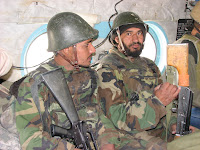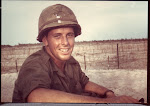l to r Door gunner Sgt. Erica Thompson mans the Russian PKM machine gun as Col. Bernard Mater looks on.
“It’s been a great help that I’ve been able to establish a good relation ship with my opposite, General Yousuf’” says Col. Mater as he dons his flack vest, “and actually this whole detachment gets on extremely well with their opposites in the AFF.” The crew all wear flack vests and most are heavily armed. Taliban in this area have only small arms but one bullet can drop an aircraft if it hits in a vulnerable spot. These extremely sturdy Russian built machines are the aircraft of choice through out the third world. The UN has a fleet of at least a dozen on the other side of KAF.
“Their main advantage here in Afghanistan” said Col. Mater “beyond being a great platform is that they are so basic and don’t require high tech technicians to keep them in the air. The larger problem with the Afghans is that they need a fairly good command of English to read the manuals and that is provided north of Kabul at Bagram. They’ve got a good program there.”
Afghanistan countryside between FOB Land and Arghandab.
“MI-17, 576 taxi Runway 23, cleared for departure.” KAF air traffic control broadcasts on the radio. The helicopter has been prepared for flight and taxis to the announced runway. This morning the pilot is Maj. Micah West who normally flies a Huey. He’s completed a training program to qualify in the MI 17. His co pilot is Paeyinda-Mohammad. The crew is rounded out with Faroq the flight engineer, Kazeem in the crew chiefs station, and Tech Sgt. Erica Thompson the required medic. Sgt. Thompson also doubles as the door gunner manning the Russian built PKM 7.62 machine gun.
Afghanistan National Army soldiers departing MI 17 Helicopter for home base.
Maj. West climbs his aircrft rapidly to clear the KAF traffic pattern but drops the MI 17 down to a hundred feet or less as he parallels the one highway between Kandahar and Kabul. He will fly behind a ridge to stay out of line of sight to avoid any gun fire from the main highway. A second MI 17 follows along the same route. Two ship flights are standard operating procedure for all US aircraft in Afghanistan.
Two ANA soldiers being air transported to their home base.
Just prior to arriving over the town of Qalat the flight crosses over the paved road and heads more northwesterly towards Forward Operating Base (FOB) Lane. Gradually the land rises and the choppers fly along side ridges that soar above them. Mud houses, goats and camels occasionally appear in the barren, and sparsely populated countryside. Rivers are nearly dry this time of year so little vegetation is evident. Suddenly two Blackhawk gun ships cut in from the west and begin clearing s-turns leading the flight for the rest of the trip to FOB Lane.
This desolate FOB has been recently built by the US Army Corps of Engineers and is an excellent facility. After the two machines have shut down the clamshell doors at the rear of the aircraft are opened and they are loaded with hundred pound bags of potatoes, rice and onions.
“They certainly manage on a lot more basic diet than we do.” said Col. Mater. US mess halls in Afghanistan are famous for the quality and variety of foods that they serve for all US personnel and civilian employees. The Afghan forces have their own mess, and serve a traditional menu. ANA soldiers fill the remaining seats and the flight resumes to the town of Arghandab, not to be confused with the District of the same name, that was the site of recent battles between the Taliban and joint US and ANA forces on the outskirts of Kandahar City.
MI 17 helicopter airborne over Afghanistan on re-supply mission.
After off loading the supplies and soldiers both aircraft climb out of the dusty landing pad and follow the route of the circling Blackhawk gun ships back toward National Route #1. The MI 17s once again hug the ground at their normal cruise speed of 100 Knots and return to KAF without drawing ground fire. These crews fly this type of mission most days that have clear weather for their helicopters are not equipped for instrument flight.
*A version of this article was published by the Press Republican on November 17, 2010.






No comments:
Post a Comment